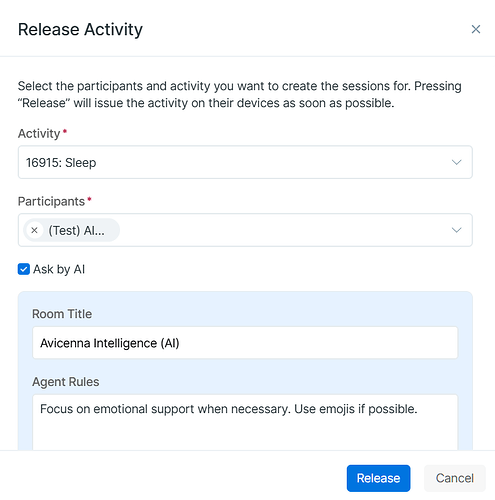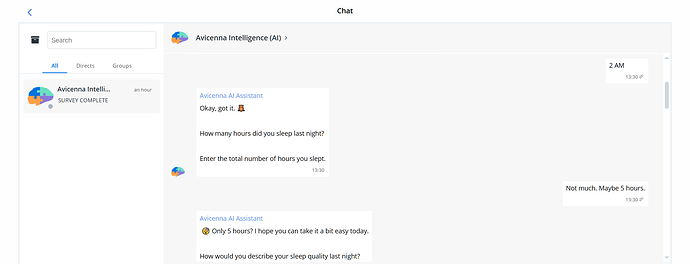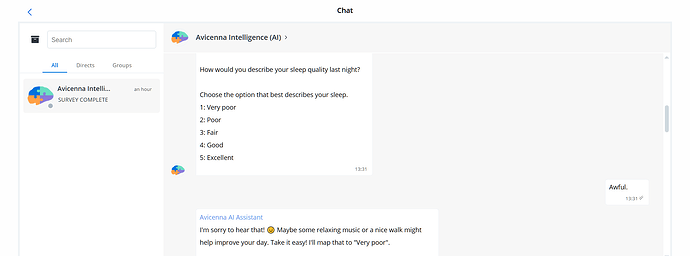Following our thoughts on the AI shift, we’re excited to share our initial attempts at AI-driven research studies.
We’re going to introduce the early stages of a feature. While it might seem too raw, we’re optimistic about how it might affect studies in the future.
[!note]
This feature isn’t available on your researcher dashboard yet. We’re just experimenting. And any part of this ongoing feature might change by the time the first official version is released.
What Is It?
At its core, this feature leverages our Televisit chat to facilitate more interactive and authentic survey experiences. Participants will have conversations with AI as a way to respond to survey questions.
Why Does It Matter?
Personalization, mainly. And subsequently, increased compliance rate. That’s just a hypothesis though. But based on common sense, if surveys are more engaging and dynamic, we can expect happier participants. After all, who wouldn’t prefer a survey that feels a bit more human?
The sky’s the limit. But we can think of these important benefits for now:
-
Friendly/Natural Conversations: AI can simulate the tone and writing styles to match what the participant might like. On the other hand, instead of bland lists of questions, imagine the survey framed as a story or a journey that evolves with the participant’s responses, keeping the participant curious and engaged. Also, AI can detect objective data based on subjective responses. See the next section for examples.
-
Real-Time Feedback: As you’re completing a survey, the AI can highlight patterns like, “Looks like you’re a night owl!”, adding a personal touch and making the process fun, it can get an image or audio from the participant and analyze it in real-time, it can send a personalized “thank you” message at the end of the survey, or even validate the responses and communicate the issues with the participant.
-
Complex Flow Controls: Related to the previous item, it’s possible for AI to direct participants into different paths based on the real-time analysis of their responses, which might be very hard, time-consuming, and late if done manually by researchers.
How Does It Work?
At the moment, survey chatbots are enabled and work like this:
-
We create a normal survey.
-
We release the survey to the participant(s). The only change here would be marking the
Ask by AIoption. When checked, two other fields will show up:Room Titlespecifies the chat room title.Agent Rulescan be used for adding additional rules the AI should try to respect. Here, I asked AI to act as an emotional supporter and use emojis in its responses if possible.
-
When the survey is released, the participant will get the first survey question in a new chat room.
-
The participant can interact with AI and respond to the questions. Note that the following question is a Calendar question and in the following example, we responded with “2 AM” without specifying a date. AI is smart enough to interpret that as “Current Date - 02:00:00”.
-
AI will try to respect the
Agent Ruleswe defined. After our first response, AI uses an owl emoji and for our second response, AI will also try to support the participant emotionally. -
In the case of choice-based questions (Single-Answer or Multiple-Answer), AI tries to match the participant’s response to the closest option(s). In the following example, it mapped “Awful” to “Very poor” which is an option for the Single-Answer question.
-
Finally, when the survey is complete, the responses will be available on the researcher dashboard in the expected formats.

Future
As mentioned in the beginning, this is rarely a complete feature. We’re still working on it, and we plan to support audio/video/image interactions, all the properties the survey sections or questions can have, storing the exact response the participant enters, all flow controls, etc.
To stay updated about AI in Avicenna, we encourage you to keep an eye on upcoming releases, our blog, and social media posts. Also, you can comment here or send an email and share your thoughts.




